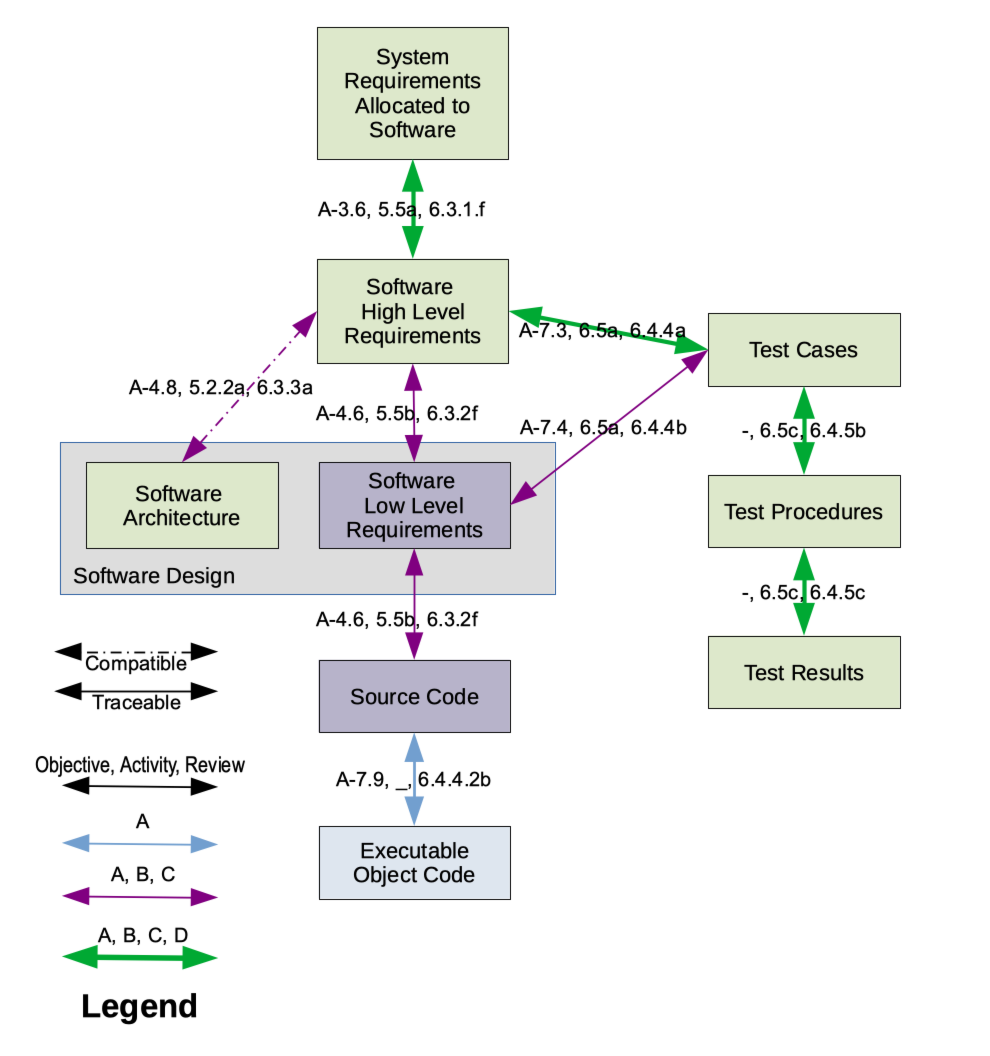|
AC 00-69
The Advisory Circular AC 00-69, ''Best Practices for Airborne Software Development Assurance Using EUROCAE ED-12( ) and RTCA DO-178( )'', initially issued in 2017, supports application of the active revisions of ED-12C/DO-178C and AC 20-115. The AC does not state FAA guidance, but rather provides information in the form of complementary "best practices". * Notably, the guidance of FAA Order 8110.49 regarding "Software Change Impact Analysis Change impact analysis (IA) or impact analysis is the analysis of changes within a deployed product or application and their potential consequences. Change impact analysis is defined by Bohnner and Arnold as "identifying the potential consequenc ..." was removed in Rev A of that notice in 2018. The best practices that AC 00-69 now describes for Software Change Impact Analysis are much reduced and less prescriptive than what was removed from 8110.49. * This AC clarifies that Data Coupling Analysis and Control Coupling Analysis are disti ... [...More Info...] [...Related Items...] OR: [Wikipedia] [Google] [Baidu] |
Advisory Circular
__NOTOC__ Advisory circular (AC) refers to a type of publication offered by the Federal Aviation Administration (FAA) to provide guidance for compliance with airworthiness regulations, pilot certification, operational standards, training standards, and any other rules within the 14 CFR Aeronautics and Space Title. They define acceptable means, but not the only means, of accomplishing or showing compliance with airworthiness regulations. Generally informative in nature, Advisory Circulars are neither binding nor regulatory; yet some have the effect of ''de facto'' standards or regulations. Advisory circulars typically refer to industry standards from SAE (ARP) and RTCA (DO). With harmonization of technical content and guidance between EASA and the FAA, later advisory circulars also identify corresponding EUROCAE (ED) publications. Some advisory circulars are only a few pages long and do little more than reference a recommended standard; for example, AC 20-152 referencing DO ... [...More Info...] [...Related Items...] OR: [Wikipedia] [Google] [Baidu] |
DO-178C
DO-178C, Software Considerations in Airborne Systems and Equipment Certification is the primary document by which the certification authorities such as FAA, EASA and Transport Canada approve all commercial software-based aerospace systems. The document is published by RTCA, Incorporated, in a joint effort with EUROCAE, and replaces DO-178B. The new document is called DO-178C/ED-12C and was completed in November 2011 and approved by the RTCA in December 2011. It became available for sale and use in January 2012. Except for FAR 33/ JAR E, the Federal Aviation Regulations do not directly reference software airworthiness. On 19 Jul 2013, the FAA approved AC 20-115C, designating DO-178C a recognized "acceptable means, but not the only means, for showing compliance with the applicable FAR airworthiness regulations for the software aspects of airborne systems and equipment certification." Background Since the release of DO-178B, there had been strong calls by DERs (FAA Designa ... [...More Info...] [...Related Items...] OR: [Wikipedia] [Google] [Baidu] |
AC 20-115
The Advisory Circular __NOTOC__ Advisory circular (AC) refers to a type of publication offered by the Federal Aviation Administration (FAA) to provide guidance for compliance with airworthiness regulations, pilot certification, operational standards, training standards, ... AC 20-115(), Airborne Software Development Assurance Using EUROCAE ED-12( ) and RTCA DO-178( ) (previously Airborne Software Assurance), identifies the RTCA published standard DO-178 as defining a suitable means for demonstrating compliance for the use of software within aircraft systems. The present revision D of the circular identifies ED-12/DO-178 Revision C as the active revision of that standard and particularly acknowledges the synchronization of ED-12 and DO-178 at that revision. This Advisory Circular calls attention to ED-12C/DO-178C as "an acceptable means, but not the only means," to secure FAA approval of software. The earliest revisions of the Advisory Circular were brief, serving little more than ... [...More Info...] [...Related Items...] OR: [Wikipedia] [Google] [Baidu] |
Best Practice
A best practice is a method or technique that has been generally accepted as superior to other known alternatives because it often produces results that are superior to those achieved by other means or because it has become a standard way of doing things, e.g., a standard way of complying with legal or ethical requirements. Best practices are used to maintain quality as an alternative to mandatory legislated standards and can be based on self-assessment or benchmarking. Best practice is a feature of accredited management standards such as ISO 9000 and ISO 14001. Some consulting firms specialize in the area of best practice and offer ready-made templates to standardize business process documentation. Sometimes a best practice is not applicable or is inappropriate for a particular organization's needs. A key strategic talent required when applying best practice to organizations is the ability to balance the unique qualities of an organization with the practices that it has in commo ... [...More Info...] [...Related Items...] OR: [Wikipedia] [Google] [Baidu] |
FAA Order 8110
The Federal Aviation Administration (FAA) is the largest transportation agency of the U.S. government and regulates all aspects of civil aviation in the country as well as over surrounding international waters. Its powers include air traffic management, certification of personnel and aircraft, setting standards for airports, and protection of U.S. assets during the launch or re-entry of commercial space vehicles. Powers over neighboring international waters were delegated to the FAA by authority of the International Civil Aviation Organization. Created in , the FAA replaced the former Civil Aeronautics Administration (CAA) and later became an agency within the U.S. Department of Transportation. Major functions The FAA's roles include: *Regulating U.S. commercial space transportation *Regulating air navigation facilities' geometric and flight inspection standards *Encouraging and developing civil aeronautics, including new aviation technology *Issuing, suspending, or revoking ... [...More Info...] [...Related Items...] OR: [Wikipedia] [Google] [Baidu] |
Change Impact Analysis
Change impact analysis (IA) or impact analysis is the analysis of changes within a deployed product or application and their potential consequences. Change impact analysis is defined by Bohnner and Arnold as "identifying the potential consequences of a change, or estimating what needs to be modified to accomplish a change", and they focus on IA in terms of scoping changes within the details of a design. In contrast, Pfleeger and Atlee focus on the risks associated with changes and state that IA is: "the evaluation of the many risks associated with the change, including estimates of the effects on resources, effort, and schedule". Both the design details and risks associated with modifications are critical to performing IA within the change management processes. A technical colloquial term is also mentioned sometimes in this context, dependency hell. Types of impact analysis techniques IA techniques can be classified into three types: * Trace * Dependency * Experiential Bohne ... [...More Info...] [...Related Items...] OR: [Wikipedia] [Google] [Baidu] |
Data Coupling
In software engineering, coupling is the degree of interdependence between software modules; a measure of how closely connected two routines or modules are; the strength of the relationships between modules. Coupling is usually contrasted with cohesion. Low coupling often correlates with high cohesion, and vice versa. Low coupling is often thought to be a sign of a well-structured computer system and a good design, and when combined with high cohesion, supports the general goals of high readability and maintainability. History The software quality metrics of coupling and cohesion were invented by Larry Constantine in the late 1960s as part of a structured design, based on characteristics of “good” programming practices that reduced maintenance and modification costs. Structured design, including cohesion and coupling, were published in the article ''Stevens, Myers & Constantine'' (1974) and the book ''Yourdon & Constantine'' (1979), and the latter subsequently became stan ... [...More Info...] [...Related Items...] OR: [Wikipedia] [Google] [Baidu] |
Software Design Description
A software design description (a.k.a. software design document or SDD; just design document; also Software Design Specification) is a representation of a software design that is to be used for recording design information, addressing various design concerns, and communicating that information to the design’s stakeholders. An SDD usually accompanies an architecture diagram with pointers to detailed feature specifications of smaller pieces of the design. Practically, the description is required to coordinate a large team under a single vision, needs to be a stable reference, and outline all parts of the software and how they will work. Composition The SDD usually contains the following information: #The ''Data-driven design'' describes structures that reside within the software. Attributes and relationships between data objects dictate the choice of data structures. #The '' architecture design'' uses information flowing characteristics, and maps them into the program structure ... [...More Info...] [...Related Items...] OR: [Wikipedia] [Google] [Baidu] |
Runtime Error Detection
Runtime error detection is a software verification method that analyzes a software application as it executes and reports defects that are detected during that execution. It can be applied during unit testing, component testing, integration testing, system testing (automated/scripted or manual), or penetration testing. Runtime error detection can identify defects that manifest themselves only at runtime (for example, file overwrites) and zeroing in on the root causes of the application crashing, running slowly, or behaving unpredictably. Defects commonly detected by runtime error detection include: * Race conditions * Exceptions * Resource leaks * Memory leaks * Security attack vulnerabilities (e.g., SQL injection) * Null pointers * Uninitialized memory * Buffer overflows Runtime error detection tools can only detect errors in the executed control flow of the application. [...More Info...] [...Related Items...] OR: [Wikipedia] [Google] [Baidu] |
Avionics
Avionics (a blend of ''aviation'' and ''electronics'') are the electronic systems used on aircraft. Avionic systems include communications, navigation, the display and management of multiple systems, and the hundreds of systems that are fitted to aircraft to perform individual functions. These can be as simple as a searchlight for a police helicopter or as complicated as the tactical system for an airborne early warning platform. History The term "avionics" was coined in 1949 by Philip J. Klass, senior editor at ''Aviation Week & Space Technology'' magazine as a portmanteau of "aviation electronics". Radio communication was first used in aircraft just prior to World War I. The first airborne radios were in zeppelins, but the military sparked development of light radio sets that could be carried by heavier-than-air craft, so that aerial reconnaissance biplanes could report their observations immediately in case they were shot down. The first experimental radio transmission ... [...More Info...] [...Related Items...] OR: [Wikipedia] [Google] [Baidu] |
Safety
Safety is the state of being "safe", the condition of being protected from harm or other danger. Safety can also refer to the control of recognized hazards in order to achieve an acceptable level of risk. Meanings There are two slightly different meanings of ''safety''. For example, ''home safety'' may indicate a building's ability to protect against external harm events (such as weather, home invasion, etc.), or may indicate that its internal installations (such as appliances, stairs, etc.) are safe (not dangerous or harmful) for its inhabitants. Discussions of safety often include mention of related terms. Security is such a term. With time the definitions between these two have often become interchanged, equated, and frequently appear juxtaposed in the same sentence. Readers unfortunately are left to conclude whether they comprise a redundancy. This confuses the uniqueness that should be reserved for each by itself. When seen as unique, as we intend here, each term will ... [...More Info...] [...Related Items...] OR: [Wikipedia] [Google] [Baidu] |

